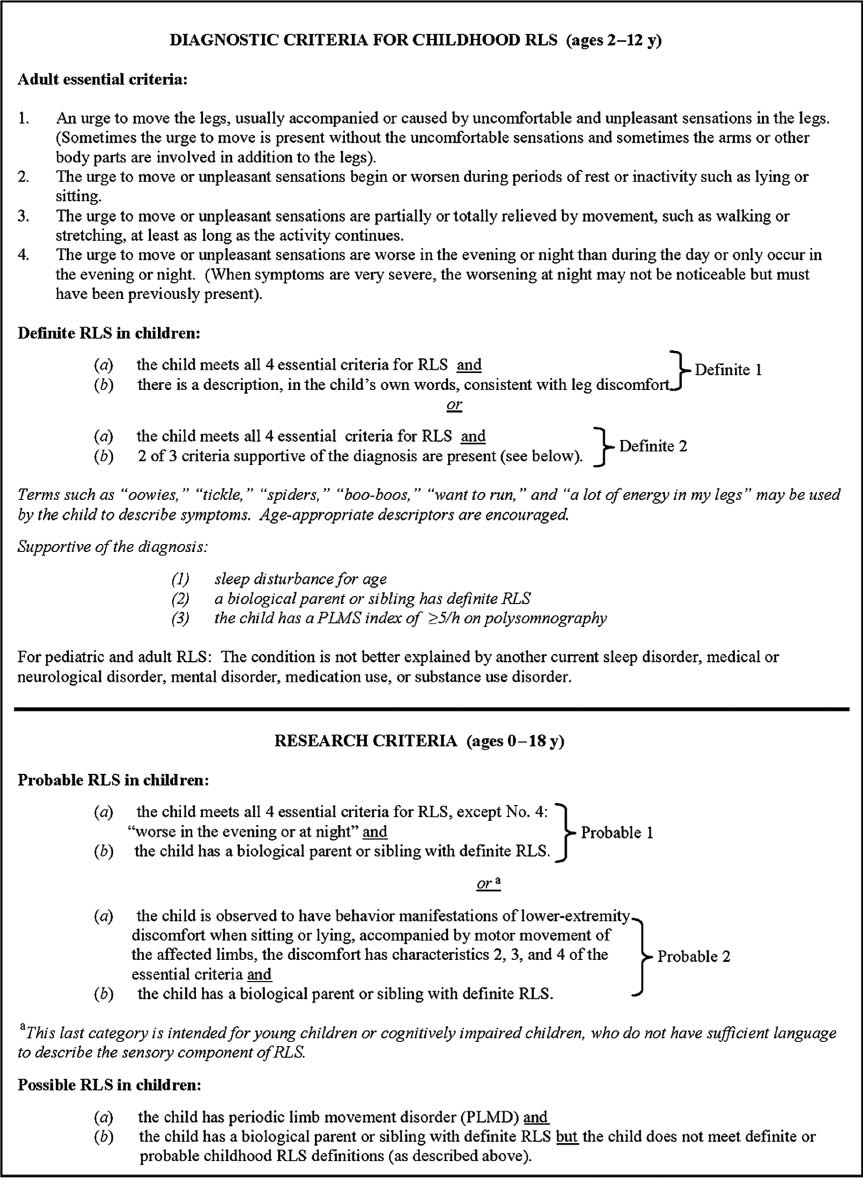Abstract
Background: Restless Legs Syndrome is the urge to move one’s legs, which often coexists with an uncomfortable sensation deep within one’s legs, but is usually not painful. Movement of one’s legs provides immediate relief and continued movement provides ongoing relief. Previous studies have not exhaustively explored the prevalence and diagnosis of Restless Legs Syndrome in an Indian adolescent population.
Methods: Using stratified random sampling the schools in Belgaum city were divided into three strata (Government, Aided, and Unaided), and from these strata using the simple randomization technique schools were selected to collect the data. A total of 100 children were recruited from the selected schools using the simple randomization technique. These children were then given the ‘Screening Questionnaire for Restless Legs Syndrome’ to be filled out in their school.
Results: Results suggest that 46.5% of adolescents are at a risk of Probable Restless Legs Syndrome, and of these around 14.14% of adolescents have Probable Restless Legs Syndrome. No gender difference was observed in the study.
Conclusions: The results of the present study conclude that Restless Legs Syndrome is prevalent in adolescent school children.

Diagnostic criteria set by the International Society of Restless Legs Syndrome.
References
1. Murray TJ, Halifax NS. The restless leg syndrome. CMAJ 1967;9:1571–4.Suche in Google Scholar
2. Chaudhuri KR. The restless legs syndrome: time to recognise the common movement disorder. Pract Neurol 2003;3: 204–13.10.1046/j.1474-7766.2003.09160.xSuche in Google Scholar
3. Patrick L. Restless legs syndrome: pathophysiology and the role of iron and folate. Altern Med Rev 2007;12:101–12.Suche in Google Scholar
4. Picchietti D, Allen RP, Walters AS, Davidson JE, Myers A, Ferini-Strambi L. Restless legs syndrome: prevalence and impact in children and adolescents – the Peds REST study. Pediatrics 2007;120:253–66.10.1542/peds.2006-2767Suche in Google Scholar
5. Allen RP, Walters AS, Montplaisir J, Hening W, Myers A, Bell TJ, et al. Restless legs syndrome prevalence and impact, REST General Population Study. Arch Int Med 2005;165: 1286–92.10.1001/archinte.165.11.1286Suche in Google Scholar
6. Earley CJ. Restless legs syndrome. N Engl J Med 2003;348:2103–9.10.1056/NEJMcp021288Suche in Google Scholar
7. Chahine LM, Chemali ZN. Restless legs syndrome: a review. CNS Spectr 2006;11:511–20.10.1017/S1092852900013547Suche in Google Scholar
8. Trophy M, Ehrenberg BL, Hening WA, Mahowald M, Malow B, Philips B, et al. Restless legs syndrome. NIH Publ 2000; 1–16.Suche in Google Scholar
9. Simakajornboona N, Kheirandish-Gozalb L, Gozalb D. Diagnosis and management of restless legs syndrome in children. Sleep Med Rev 2009;1:149–56.10.1016/j.smrv.2008.12.002Suche in Google Scholar
10. Pullen SJ, Wall A, Angstman ER, Munitz GE, Kotagal S. Psychiatric comorbidity in children and adolescents with restless legs syndrome: a retrospective study. J Clin Sleep Med 2011;7:587–96.10.5664/jcsm.1456Suche in Google Scholar
11. Trenkwalder C, Paulus W, Walters AS. The restless legs syndrome. Lancet Neurol 2005;4:465–75.10.1016/S1474-4422(05)70139-3Suche in Google Scholar
12. Clemens S, Rye D, Hochman S. Restless legs syndrome: revisiting the dopamine hypothesis from the spinal cord perspective. Neurology 2006;67:125–30.10.1212/01.wnl.0000223316.53428.c9Suche in Google Scholar PubMed
13. Young JE, Vilariño-Güell C, Lin S-C, Wszolek ZK, Farrer MJ. Clinical and genetic description of a family with a high prevalence of autosomal dominant restless legs syndrome. Mayo Clin Proc 2009;84:134–8.10.4065/84.2.134Suche in Google Scholar
14. Garcia-Borreguero D, Stillman P, Benes H, Buschmann H, Chaudhuri KR, Gonzalez Rodríguez VM, et al. Algorithms for the diagnosis and treatment of restless legs syndrome in primary care. BMC Neurol 2011;11:28.10.1186/1471-2377-11-28Suche in Google Scholar PubMed PubMed Central
15. Berger K, Luedemann J, Trenkwalder C, Johm U, Kessler C. Sex and risk of restless legs syndrome in the general population. Arch Int Med 2004;164:196–202.10.1001/archinte.164.2.196Suche in Google Scholar PubMed
©2015 by De Gruyter
Artikel in diesem Heft
- Frontmatter
- Review
- Confucian thoughts on special education in China: key thoughts and impact
- Original Articles
- Vision of Israeli physical therapy national directors on the future development of the profession
- Computer-aided animated gesture-driven facial model with speech synthesis
- Restless Legs Syndrome in adolescent school children in Belgaum city: a cross-sectional study
- A one-year retrospective review of vitamin D level, bone profile, liver function tests and body mass index in children with cystic fibrosis in a children’s university hospital
- Analysis of the positioning of the head, trunk, and upper limbs during gait in children with visual impairment
- Cultural translation of a domestic violence intervention for small children: key policy and practice directions
- Sense of coherence and WHOQoL among parents of children with ASD in Malaysia
- Phonetic environment of disfluencies in children with stuttering
- Parental perception of developmental vulnerability after inter-country adoption: a 10-year follow-up study: longitudinal study after inter-country adoption
- Quantitative analysis of static equilibrium in women after mastectomy
- The relationship between sports teachers’ reports, motor performance and perceived self-efficacy of children with developmental coordination disorders
- Case Report
- Ectrodactyly ectodermal dysplasia cleft lip/palate (EEC) syndrome in a family
Artikel in diesem Heft
- Frontmatter
- Review
- Confucian thoughts on special education in China: key thoughts and impact
- Original Articles
- Vision of Israeli physical therapy national directors on the future development of the profession
- Computer-aided animated gesture-driven facial model with speech synthesis
- Restless Legs Syndrome in adolescent school children in Belgaum city: a cross-sectional study
- A one-year retrospective review of vitamin D level, bone profile, liver function tests and body mass index in children with cystic fibrosis in a children’s university hospital
- Analysis of the positioning of the head, trunk, and upper limbs during gait in children with visual impairment
- Cultural translation of a domestic violence intervention for small children: key policy and practice directions
- Sense of coherence and WHOQoL among parents of children with ASD in Malaysia
- Phonetic environment of disfluencies in children with stuttering
- Parental perception of developmental vulnerability after inter-country adoption: a 10-year follow-up study: longitudinal study after inter-country adoption
- Quantitative analysis of static equilibrium in women after mastectomy
- The relationship between sports teachers’ reports, motor performance and perceived self-efficacy of children with developmental coordination disorders
- Case Report
- Ectrodactyly ectodermal dysplasia cleft lip/palate (EEC) syndrome in a family

